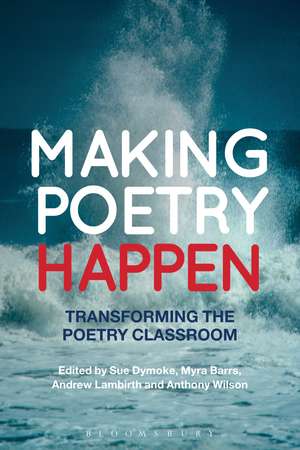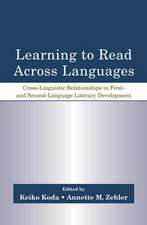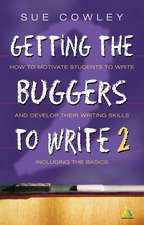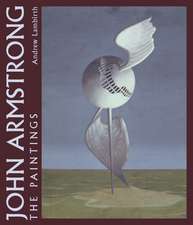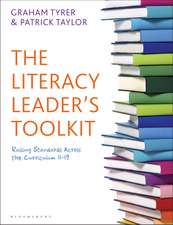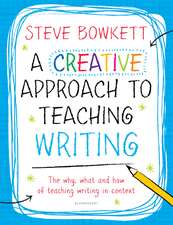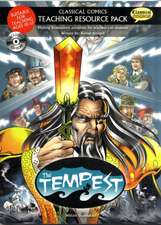Making Poetry Happen: Transforming the Poetry Classroom
Editat de Dr Sue Dymoke, Dr Myra Barrs, Dr Andrew Lambirth, Dr Anthony Wilsonen Limba Engleză Paperback – 28 ian 2015
| Toate formatele și edițiile | Preț | Express |
|---|---|---|
| Paperback (1) | 251.39 lei 6-8 săpt. | |
| Bloomsbury Publishing – 28 ian 2015 | 251.39 lei 6-8 săpt. | |
| Hardback (1) | 890.72 lei 6-8 săpt. | |
| Bloomsbury Publishing – 28 ian 2015 | 890.72 lei 6-8 săpt. |
Preț: 251.39 lei
Preț vechi: 288.69 lei
-13% Nou
Puncte Express: 377
Preț estimativ în valută:
48.11€ • 50.04$ • 39.72£
48.11€ • 50.04$ • 39.72£
Carte tipărită la comandă
Livrare economică 14-28 aprilie
Preluare comenzi: 021 569.72.76
Specificații
ISBN-13: 9781472512383
ISBN-10: 1472512383
Pagini: 248
Dimensiuni: 156 x 234 x 15 mm
Greutate: 0.39 kg
Editura: Bloomsbury Publishing
Colecția Bloomsbury Academic
Locul publicării:London, United Kingdom
ISBN-10: 1472512383
Pagini: 248
Dimensiuni: 156 x 234 x 15 mm
Greutate: 0.39 kg
Editura: Bloomsbury Publishing
Colecția Bloomsbury Academic
Locul publicării:London, United Kingdom
Caracteristici
Supports teachers working within the restrictions of performative 'high stakes' English curricula around the world
Notă biografică
Sue Dymoke is Reader in Education in the School of Education at the University of Leicester, UK, where she is Course Leader of the Secondary PGCE.Myra Barrs is a freelance writer and researcher working in education. She was formerly Director of the Centre for Literacy in Primary Education, UK.Andrew Lambirth is Professor of Education in the Faculty of Education and Health at the University of Greenwich, UK.Anthony Wilson is Senior Lecturer in the Graduate School of Education at the University of Exeter, UK, where he is Subject Leader for PCGE Primary English.
Cuprins
List of Figures and TablesPublisher's AcknowledgementsAbout the Contributors1.Introduction, Sue Dymoke (University of Leicester, UK), Myra Barrs (University of East London, UK), Andrew Lambirth (University of Greenwich, UK) and Anthony Wilson (University of Exeter, UK) Part I: Reading Poetry (section editor: Andrew Lambirth)2. The Challenges and Opportunities for Engaging with Poetry, Nicholas McGuinn (University of York, UK)3. Lifting Poetry off the Page, Susanna Steele (University of Greenwich, UK) 4. Case Study I: Critical Reading and Student Engagement with Poetry, Daniel Xerri (Sixth College, Malta) 5. Case Study II: Not 'Puppets on a String': Learning to Love Teaching Poetry, Andrew Lambirth (University of Greenwich, UK) 6. Commentary and Practical Implications: Righting the 'Wrong Kind of Orientation', Andrew Lambirth (University of Greenwich, UK) Part II: Writing Poetry (section editor: Myra Barrs)7. Inspiring Young People to Write Poems, Cliff Yates (poet, UK) 8. Teaching Poetry Based on Actual Writing Practices, Mandy Coe (poet, UK)9. Case Study III: Becoming a Poetry School, Jennie Clark (Churchfields Infants School, London Borough of Redbridge) with Myra Barrs (University of East London, UK)10. Case Study IV: Why Poetry Matters in the Primary School, Sue Ellis (Institute of Education, University of London, UK) and Amy Clifford (Torriano Infant School, UK)11. Case Study V: Making Poetry Happen in a Sixth Form Environment, Jane Bluett (Bilborough Sixth Form College, UK) 12. Commentary and Practical Implications: A Flicker in the Mind, Myra Barrs (University of East London, UK)Part III: Speaking and Listening to Poetry (section editor: Sue Dymoke)13. Poetry, Listening and Learning, Julie Blake (Poetry Archive, UK) 14. Rhyme Workshops, Andy Craven-Griffiths (poet, UK) 15. Slam Poetry, Joelle Taylor (SLAMbassadors UK, UK) 16. Case Study VII: How English Teachers Make Use of Slam Poetry in a Secondary School Setting, Christopher Parton (Robert Sutton Catholic Specialist Sports College, UK) 17. Case Study VIII, Gothic Poetry, Brenda Ainsley (Kibworth High School, UK) 18. Commentary and Practical Implications: Inside the Poem's Engine Room, Sue Dymoke (University of Leicester, UK)Part IV: Transformative Poetry Cultures (section editor: Anthony Wilson)19. Building Children's and Teachers' Interest and Confidence in Poetry, Jenny Vernon (Centre for Literacy in Primary Education (CLPE), UK) 20. Engaging Invisible Pupils through Creative Writing, Emma Beynon (freelance creative practitioner currently running opengroundwriting.co.uk) 21. Case Study VIII: Effective Practices with English as an Additional Language (EAL) Learners, Vicky Macleroy (Goldsmith's College, University of London, UK) 22. Case Study IX: Digital Literacy, Janette Hughes (University of Ontario Institute of Technology, Canada) 23. Commentary and Practical Implications: A Pedagogy of Permission, Anthony Wilson (University of Exeter, UK) 24. Conclusion, Anthony Wilson (University of Exeter, UK), Myra Barrs (University of East London, UK), Sue Dymoke (University of Leicester, UK) and Andrew Lambirth (University of Greenwich, UK) GlossaryReferencesIndex
Recenzii
Both [this book and Making Poetry Matter] offer reassuring and affirming accounts of the innate power of poetry as a means of expressing identity and individuality in the classroom. ... [They] replace fears and anxieties with practical strategies and evidence of how creative and shared approaches to poetry can empower students within the classroom environment and beyond.
Packed with energy and ideas, this engaging book is a must-have for poetry teachers across the age phases. Accessible workshop activities for the classroom show how to bring poetry alive on the tongue, in the mind and the body. Pleasure and play rub shoulders with attention to language, interpretation and meaning, and conspire to inspire. A book to read, use and enjoy.
Rich in classroom experiences of the teaching of poetry, and covering a wide range of important issues, this book allows teachers and educators to take us on their journey of discovering the power of poetry.
This is an outstanding collection that gives voice to teachers and students as they engage with poetry. It is essential reading for those who want to make poetry happen. An invaluable resource for new and experienced teachers, this text will change how you approach poetry. Rarely have I read a book that is so transformative. Making Poetry Happen will become a classic.
I can think of no more comprehensive or up-to-date volume on the teaching of poetry today. Editors Dymoke, Barrs, Lambirth and Wilson have assembled twenty-four chapters that span the full range of possibilities for engaging students from early primary to late secondary school in reading, writing, performing and studying every conceivable poetic genre. Here are approaches that are practically, pedagogically and theoretically sound, and that will reassure the most anxious teacher and encourage the most reluctant student. What an extraordinary resource for language arts teachers around the world.
Making Poetry Happen is an engaging exploration of the matters arising within curricular and their consequences in the poetry classroom. Exercises, case studies, anecdotes and relevant research from numerous student and teacher perspectives guide a transformative approach to the teaching of poetry. Encompassing the many facets of poetry and reaching across year levels and countries, this book shows how poetry can be the making of education.Informed by researchers, teachers, writers and poets who are teachers, this book offers expansive pedagogical approaches to revitalise poetics in education, working alongside, and independently of, the companion book, Making Poetry Matter. Making Poetry Happen does not tell teachers how to teach. It is a poetry bible. Written by teachers for teachers to share the wild heart of poetics in the classroom.
Packed with energy and ideas, this engaging book is a must-have for poetry teachers across the age phases. Accessible workshop activities for the classroom show how to bring poetry alive on the tongue, in the mind and the body. Pleasure and play rub shoulders with attention to language, interpretation and meaning, and conspire to inspire. A book to read, use and enjoy.
Rich in classroom experiences of the teaching of poetry, and covering a wide range of important issues, this book allows teachers and educators to take us on their journey of discovering the power of poetry.
This is an outstanding collection that gives voice to teachers and students as they engage with poetry. It is essential reading for those who want to make poetry happen. An invaluable resource for new and experienced teachers, this text will change how you approach poetry. Rarely have I read a book that is so transformative. Making Poetry Happen will become a classic.
I can think of no more comprehensive or up-to-date volume on the teaching of poetry today. Editors Dymoke, Barrs, Lambirth and Wilson have assembled twenty-four chapters that span the full range of possibilities for engaging students from early primary to late secondary school in reading, writing, performing and studying every conceivable poetic genre. Here are approaches that are practically, pedagogically and theoretically sound, and that will reassure the most anxious teacher and encourage the most reluctant student. What an extraordinary resource for language arts teachers around the world.
Making Poetry Happen is an engaging exploration of the matters arising within curricular and their consequences in the poetry classroom. Exercises, case studies, anecdotes and relevant research from numerous student and teacher perspectives guide a transformative approach to the teaching of poetry. Encompassing the many facets of poetry and reaching across year levels and countries, this book shows how poetry can be the making of education.Informed by researchers, teachers, writers and poets who are teachers, this book offers expansive pedagogical approaches to revitalise poetics in education, working alongside, and independently of, the companion book, Making Poetry Matter. Making Poetry Happen does not tell teachers how to teach. It is a poetry bible. Written by teachers for teachers to share the wild heart of poetics in the classroom.
